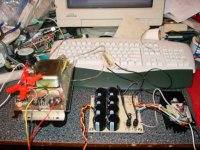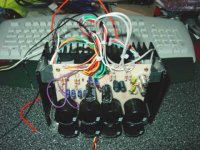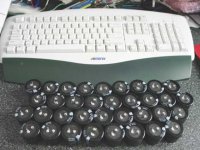Next, the testing to ensure nothing lets out any magic smoke when the almost 90 volts of DC gets thrown into the mix.
Nothing smoke-tested itself, amazingly enough. And the sound from the speaker connected to it wasn't bad at all, although I prefer a little more bass boost than my unaltered/not-equalized signal carried. I did notice a little ringing in the upper end of the freq. range, which makes me think I need to throw a Zobel network across the output to squelch any harmonics.
I have 2x 6800uF across the two rails at the transformer side, and the amp filter/support-circuit board has 8x 3300uF caps on it. With it pumping 5 watts RMS into a 4-ohm load, it takes about five seconds to drain the charge.
BTW, yes, my desk is that messy. 😀
oO
Nothing smoke-tested itself, amazingly enough. And the sound from the speaker connected to it wasn't bad at all, although I prefer a little more bass boost than my unaltered/not-equalized signal carried. I did notice a little ringing in the upper end of the freq. range, which makes me think I need to throw a Zobel network across the output to squelch any harmonics.
I have 2x 6800uF across the two rails at the transformer side, and the amp filter/support-circuit board has 8x 3300uF caps on it. With it pumping 5 watts RMS into a 4-ohm load, it takes about five seconds to drain the charge.

BTW, yes, my desk is that messy. 😀
oO
Attachments
Update:
I added a pair of 0.1uF 100VDC mylar caps across the two supply rails (both capped to ground) and the ringing I had heard in my earlier test went away completely. Response was suddenly surprisingly flat as well.
I installed the second TDA7293 and bolted both to the smaller heatsink (pictured above), and ran both into a 4-ohm load. The resulting sound quality was better than I expected for a pair of amp modules, with plenty of oomph available on demand. Thanks to the almost ridiculous amount of capacitance in the supply (20,000uF total per rail) bass response was better than I expected, even with no tone controls whatsoever in-circuit and no tone modifications from the computer that was providing the sinewaves for testing.
Tomorrow I plan to give the rig a harder test by running up the volume to about drive about 70W RMS/channel into the speakers, and see how well it handles the force.
My next trick will be to add two more 7293s in slave mode to parallel the outputs.
oO
I added a pair of 0.1uF 100VDC mylar caps across the two supply rails (both capped to ground) and the ringing I had heard in my earlier test went away completely. Response was suddenly surprisingly flat as well.
I installed the second TDA7293 and bolted both to the smaller heatsink (pictured above), and ran both into a 4-ohm load. The resulting sound quality was better than I expected for a pair of amp modules, with plenty of oomph available on demand. Thanks to the almost ridiculous amount of capacitance in the supply (20,000uF total per rail) bass response was better than I expected, even with no tone controls whatsoever in-circuit and no tone modifications from the computer that was providing the sinewaves for testing.
Tomorrow I plan to give the rig a harder test by running up the volume to about drive about 70W RMS/channel into the speakers, and see how well it handles the force.
My next trick will be to add two more 7293s in slave mode to parallel the outputs.
oO
Most things is going well.
Not much to say, as you are getting along
so well with your project.
Interesting that so small caps as 0.1uF
across supply can make a difference.
The power supply is really taken god care of with all that capacitance, parallelled small ones.
What Zobel is recommended for TDA7293?
Everything that is good when using 4 ohms speaker
will not be worse when using 8 ohms.
Seems that many chipdesigners use 4 ohms as a lower target value for the load. 😎
Not much to say, as you are getting along
so well with your project.
Interesting that so small caps as 0.1uF
across supply can make a difference.
The power supply is really taken god care of with all that capacitance, parallelled small ones.
What Zobel is recommended for TDA7293?
Everything that is good when using 4 ohms speaker
will not be worse when using 8 ohms.
Seems that many chipdesigners use 4 ohms as a lower target value for the load. 😎
Re: Most things is going well.
Yep, a few small caps can make a word of difference.
The Zobel the spec sheet suggests is a 3.9 ohm (2W) resistor and 1uF capacitor.
oO
halojoy said:Not much to say, as you are getting along
so well with your project.
Interesting that so small caps as 0.1uF
across supply can make a difference.
The power supply is really taken god care of with all that capacitance, parallelled small ones.
What Zobel is recommended for TDA7293?
Everything that is good when using 4 ohms speaker
will not be worse when using 8 ohms.
Seems that many chipdesigners use 4 ohms as a lower target value for the load. 😎
Yep, a few small caps can make a word of difference.
The Zobel the spec sheet suggests is a 3.9 ohm (2W) resistor and 1uF capacitor.
oO
Quick Upgrade.
100 uF or so, smps low esr caps help very much too.
I often add such caps across the rails of standard 4in1 systems when I am servicing them, and every time the overall sound is cleaned and improved.
I get comments from customers that their budget system is nicer to live with after I have serviced them and done this.
Eric.
100 uF or so, smps low esr caps help very much too.
I often add such caps across the rails of standard 4in1 systems when I am servicing them, and every time the overall sound is cleaned and improved.
I get comments from customers that their budget system is nicer to live with after I have serviced them and done this.
Eric.
I'm thinking of sticking a 10uF and a 470uF across the rails in addition to the .1uF, in order to further clean the rails up and dampen any odd line noise.
I might as well just do it - I have the caps and can yank 'em if they don't help. 😀
oO
I might as well just do it - I have the caps and can yank 'em if they don't help. 😀
oO
heat sink
just for a reference point, Logitech makes a set of speakers called the z-560 that uses 6 of these TDA7293 chips (I know this because I bought one of these items at a swap meet cheap, and I'm searching all over the place for a couple of the chips to repair it). It uses 4 individual chips to power 4 satellite speakers, and it uses two of the chips in a bridge configuration to power the subwoofer. I haven't made any attempt to trace out the exact schematic. But, relevant to this thread, there is an 8 inch by 9 inch finned heatsink on the back. Presumably most of the heat will come from the bridged pair. So, there is a good chance that your heat sink is much smaller than it needs to be unless you choose forced air cooling.
I haven't run this for any extended time to see how it heats up - the bridged chips exploded, and after removing them I have verified that the rest of the unit seems to work. If you want, I can plug it in and let it run, no load for a while and see what happens, but this is a bit of a pain since I will have to reassemble most of it to do this.
(by the way, any hints on a source for these chips would be most welcome)
just for a reference point, Logitech makes a set of speakers called the z-560 that uses 6 of these TDA7293 chips (I know this because I bought one of these items at a swap meet cheap, and I'm searching all over the place for a couple of the chips to repair it). It uses 4 individual chips to power 4 satellite speakers, and it uses two of the chips in a bridge configuration to power the subwoofer. I haven't made any attempt to trace out the exact schematic. But, relevant to this thread, there is an 8 inch by 9 inch finned heatsink on the back. Presumably most of the heat will come from the bridged pair. So, there is a good chance that your heat sink is much smaller than it needs to be unless you choose forced air cooling.
I haven't run this for any extended time to see how it heats up - the bridged chips exploded, and after removing them I have verified that the rest of the unit seems to work. If you want, I can plug it in and let it run, no load for a while and see what happens, but this is a bit of a pain since I will have to reassemble most of it to do this.
(by the way, any hints on a source for these chips would be most welcome)
Tried to parallel one of my remaining 7293s and took out a channel. (Bugger! as a Brit would say.) I had a sense of foreboding about even trying it (the "leave well enough alone" vibe was strong) but tried anyway, and let out the magic smoke as a direct result.
So, back to one device per channel I go.
As for cooling, I'm planning on forced cooling and have already started the design work for a small portable casing for it that will incorporate some creative ducting to maximize airflow over the 'sink.
oO
So, back to one device per channel I go.
As for cooling, I'm planning on forced cooling and have already started the design work for a small portable casing for it that will incorporate some creative ducting to maximize airflow over the 'sink.
oO
More hot amp-on-heatsink action! 😀
This is what I ended up with after fashioning some mounting tabs from aluminum sheet stock I had lying around from other projects, attaching these to the heatsink, and mounting the amp support board onto them. The entire thing works as a unit - I simply provide power via supply lines and preamp-out signals to the RCA jacks on the board.
It's gapped out from the heatsink to provide the requisite air space for proper cooling, and to prevent any inductive coupling. The fat bundles of wiring emerging from the top are the umbilicals to each 7293 mounted to the heatsink.
oO
This is what I ended up with after fashioning some mounting tabs from aluminum sheet stock I had lying around from other projects, attaching these to the heatsink, and mounting the amp support board onto them. The entire thing works as a unit - I simply provide power via supply lines and preamp-out signals to the RCA jacks on the board.
It's gapped out from the heatsink to provide the requisite air space for proper cooling, and to prevent any inductive coupling. The fat bundles of wiring emerging from the top are the umbilicals to each 7293 mounted to the heatsink.
oO
Attachments
Peek-a-boo...
This pic shows the right-channel (gee, wonder what that 'R' is there for!) 7293 attached to the heatsink. Since it's a p.i.t.a. to design PC boards to accomodate offset-pin IC packages like multiwatt15s, I cooked up two boards for each 7293 - one solders to the odd pins and the other to the even pins, and umbilical cabling connects the whole works to the main supply/support board.
This arrangement lets me put decoupling caps VERY VERY VERY close to the ICs, as is evident by that metal-film 0.1uF cap staring back in the picture. At worst, the decoupling caps are half an inch from the actual IC body.
When I get the sample Kapton MT film from DuPont I'll replace those almost-too-small-to-be-useful mica insulators with cut-to-size ones.
oO
This pic shows the right-channel (gee, wonder what that 'R' is there for!) 7293 attached to the heatsink. Since it's a p.i.t.a. to design PC boards to accomodate offset-pin IC packages like multiwatt15s, I cooked up two boards for each 7293 - one solders to the odd pins and the other to the even pins, and umbilical cabling connects the whole works to the main supply/support board.
This arrangement lets me put decoupling caps VERY VERY VERY close to the ICs, as is evident by that metal-film 0.1uF cap staring back in the picture. At worst, the decoupling caps are half an inch from the actual IC body.
When I get the sample Kapton MT film from DuPont I'll replace those almost-too-small-to-be-useful mica insulators with cut-to-size ones.
oO
Attachments
Yippee, my box of capacitors came in...
They're 4,700uF 50VDC high-ripple-current/low-ESR jobs rated for power supply use. Each has a 2.7 AMP ripple current capacity. Just the ticket for putting a lot of capacitance in a smaller area than the massive Sprage/Mallory/etc. cans. (I figure I can cook another 47,000uF per rail with a populated board the size of a sheet of paper and only an inch and a half tall.)
(NOTE: Pic only shows part of the box's worth.)
oO
They're 4,700uF 50VDC high-ripple-current/low-ESR jobs rated for power supply use. Each has a 2.7 AMP ripple current capacity. Just the ticket for putting a lot of capacitance in a smaller area than the massive Sprage/Mallory/etc. cans. (I figure I can cook another 47,000uF per rail with a populated board the size of a sheet of paper and only an inch and a half tall.)
(NOTE: Pic only shows part of the box's worth.)
oO
Attachments
hey since were on the TDA72xx series subject ( nice amp there btw! ) has anyone else heard the TDA7264 chips and how do they think they sound? I've got one in my portable amp and aside from being able to scare you out of a room with some efficient speakers it sounds wonderful and must have an incredibly high SNR...that things dead silent! 😱
- Status
- Not open for further replies.
- Home
- Amplifiers
- Solid State
- Qs about a two-channel quad paralleled TDA7293 amp...



